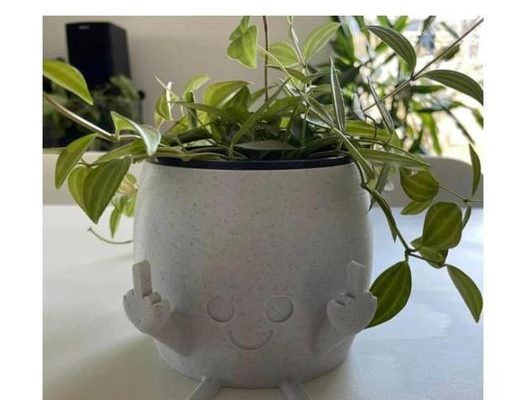Be sure to keep your Peperomia at comfortable room temperature 60° – 65° degrees Fahrenheit (15° – 18° C) all year round.
To keep your plant attractive, pinch off the yellow leaves, leaving the stem in place.
The stem will dry out within a day or two, and then remove it without hurting your plant.
Once the symptoms have gone this far, you will probably need to repot the plant, give it all new, fresh potting soil and amend your watering practices to allow the soil to dry in the future to avoid having soggy soil.
When you remove the plant from the pot, cut off any rotted portions.
If you find the roots have become mushy and brown, the condition has advanced too far, and you must simply dispose of the plant and replace it.
This could be a result of overwatering, or it could be the potting soil is just too compacted to allow the roots to get enough air.
To deal with this problem, begin with a planting medium light and airy and consists of a good amount of organic matter.
Remember to use pots made of a natural, breathable material such as terra-cotta and provide ample drainage.
While you will not be able to rescue the chlorotic lower leaves, prevent damage to the rest of the plant by following a diligent, monthly watering schedule throughout the spring and summertime using a good basic plant food diluted to half strength.
Don’t fertilize Peperomia during the autumn and the winter.
This can happen if you’re fertilizing too much.
Address this by pouring fresh, pure water through the soil until it runs clear. This will help leach excessive salt from the soil.
Alternately, repot in fresh potting soil and take care not to over-fertilize in the future.
You will recognize it by the raised areas appearing on the undersides of the leaves.
These may be mistaken for edema because the spots are irregularly shaped and swollen.
The lesions may look like weeping blisters and may be yellow, brown, or black with yellow, ring-like margins.
Address these problems by pruning away affected foliage and applying a good fungicide to all surfaces of the plant.
Improve all of the environmental conditions surrounding the plant by addressing problems such as low lighting, sudden chills, excessive humidity, poor air circulation, and overwatering.
#2 – Phyllosticta Leaf Spot: This leaf spot disease is specific to Watermelon Peperomia.
It manifests as concentric rings of dark and light tissue, which begins at the leaf margins and spreads over the entire leaf.
Address it by pruning away and destroying any leaves affected, correcting any environmental problems, and keeping the plant’s remaining foliage dry.
#3 – Rhizoctonia Leaf Spot: This type of leaf spot will cause dark brown or black mushy spots on the leaves.
The lesions may be either concentric rings or elliptical or irregularly shaped.
They may form on old or young leaves on any part of the plant.
In a very warm setting, the pathogen may form a web-like pattern over the surface of the plant.
This type of leaf spot typically affects Peperomia obtusifolia cultivars.
It is such a serious disease, it’s best to destroy plants affected by this pathogen simply.
#4 – Phytophthora spp. & Pythium spp.: These are fungal infections causing root and stem rot.
Affected plants will develop soft, rotten tissue at the soil line.
This will extend up the stem and into the leaves as mushy, black lesions.
Because the roots of the plant are affected first, they are usually destroyed, so if your plants develop these symptoms, it’s best to dispose of them simply.
Prevent infection by always using new or sterilized containers and fresh, unused potting medium.
Keep potted plants up off the ground to avoid having these pathogens enter them from the native soil.
#5 – Sclerotium Stem Rot: This type of stem rot is also known as Southern Blight.
It manifests as a mushy brown area at the soil line.
You may also see tan to dark brown, mushroom-like fruiting bodies approximately the size of mustard seeds gathered around the soft, mushy flesh of your plant.
In advanced cases, you may see white, cottony masses of fungal growth as well.
This type of stem rot is often introduced on cuttings, so be sure to inspect new stem cuttings for symptoms before adding them to your collection.
As with all fungal infections, prevent the development of this fungus by always using sterile pots and equipment and pathogen-free, fresh soil.
#6 – Anthracnose Disease: This is a group of several different types of fungal diseases affecting Peperomia and other plants kept in humid, warm areas.
The disease is also caused by a sudden chilling. It manifests as the withering, wilting and dying of plant tissues.
You may notice your radiator plants develop dry spots ranging in color from tan to black in the center of the leaves with dark, narrow margins around the leaves.
In some cases, just the ends of the leaves will darken, and dark bars of the pathogen will crisscross over the leaf.
Prune away and destroy leaves and stems affected by the disease.
By improving ventilation and stabilizing the temperature.
Spray the surviving plants with a good foliar fungicide.
Viral Disease
There is only one viral infection (Virus Ringspot or Peperomia Ringspot Virus) documented as affecting Variegated Peperomia.
It generally manifests as necrotic, brown lesions appearing randomly on the plant’s leaves.
The leaves typically fall off once infected.
Because this is a virus, there is no treatment, and infected plants must simply be destroyed.
Avoid the spread of this disease by being sure to sterilize all of your equipment (e.g., pruners, spades, etc.) between uses.
8 Insect Pests Plaguing Peperomia
Radiator plants kept indoors and properly cared for are not typically subject insect pests.
Those kept outdoors may be bothered by a wide variety of pests such as:
- Root Mealybugs
- Slugs & Snails
- Fungus Gnats
- Caterpillars
- Aphids
- Mites
- Scales
- Thrips
Generally speaking, scale insects, mites, and mealybugs will gain access to your plants when new plants are brought in without being properly inspected.
Flying insects such as thrips and fungus gnats may come in on their own.
Moths may come in and lay eggs on your plants resulting in caterpillars.
In this section, we review what to look for and what to do to avoid and deal with insect infestation of Peperomia plants.
#1 – Caterpillars: If you see holes along the edges or in the centers of leaves, suspect caterpillar infestation; however, you may also have a problem with snails or slugs.
Determine which is the problem by carefully inspecting and finding one of the culprits.
If the problem is caterpillars, manually get rid of the caterpillars by hand and drop them into a bucket of soapy water.
Introduce natural predators to your gardens, such as predatory wasps or tachinid flies, to keep them under control in the future.
Additionally, you may wish to make use of natural repellents (more on natural pesticide solutions here) or Bacillus thuringiensis (Bt) (available at Amazon).
Learn more about a Bacillus Thuringiensis application.
#2 – Snails or Slugs: Pick off the slimy offenders and drop them into a bucket of soapy water.
Sprinkle Epsom salts on the ground around your plants to discourage slugs and snails while providing your radiator plants with a nice tonic of magnesium.
More on Epsom Salt uses in the Garden
#3 – Fungus Gnats: These minuscule black flies can usually be found running around on the surface of the soil.
Their tiny, clear larvae have blackheads. They are also seen in the plant’s soil.
Sometimes you will also see the adults scurrying about on the leaves.
Adult fungus gnats are only about an eighth of an inch long and have very long, bead-like antenna.
They don’t fly well, and their long legs dangle as they bumble about.
It’s the larvae which do the damage to your plants by spinning webbing over the surface of the soil and eating both the roots and any leaves touching the soil surface.
While the damage alone is not especially problematic, it predisposes your plants to infection by bacteria, fungus, and viruses.
Chemical treatment seems to be ineffective on these pests, but simply reducing watering and increasing air circulation will discourage them.
#4 – Shore Flies are similar in appearance to fungus gnats, but you’ll usually see them sitting on the leaf tips or sitting on the soil surface where they eat algae.
Unlike fungus gnats, Shore Flies have short antennae, and they are strong fliers.
Shore Fly larvae live in the soil and are clear but do not have blackheads.
They appear not to have heads at all!
The larvae do not damage Peperomia plants and the adults-only feed on algae in the soil.
The main problem with having Shore Flies around your plants is you have Shore Flies around your plants.
They’re a nuisance, and they may very well spread pathogens from one plant to another.
Furthermore, they leave unsightly blackish/green spots on the leaves when they defecate.
Prevent Shore Fly infestation by watering less and managing any algae growth in the plant’s soil, on the outside of the pot, or in the environment surrounding your plants.
Chemicals are not effective in dealing with Shore Flies.
#5 – Mealybugs: These common houseplant pests appear as cottony, white masses on the plant’s leaf axils, as well as on the undersides of the leaves and the plant’s roots.
If left untreated, sticky honeydew and sooty mold will cover the plant causing stunted growth and, eventually, plant death. More on “What is Black Sooty Mold“?
If you catch the infestation early, dab at the mealybugs with a cotton swab or cotton ball soaked in rubbing alcohol.
Follow up by washing the plant with a mild solution of dish soap and water.
Further discourage mealybugs by spraying the plant with this solution from time-to-time.
If your plant has become heavily infested, you may need to use a soil drench of systemic pesticides to kill off root mealybugs and catch new generations as they emerge.
NOTE: If you are going to use a soil drench of pesticide, be sure the affected plant has well-draining soil and is not sitting in a plant saucer.
The solution should be able to run through the soil freely.
#6 – Mites: It’s easy to miss mites because they are very tiny, and your only clue to their presence may be damage to your plants.
Learn about getting rid of different types of mites:
If you notice the leaves of your radiator plants becoming stunted, puckered, brittle, twisted or curled, assume they have been infested by mites.
The best course of action is to prevent mite infestation simply.
Whenever you bring new plants home, be sure to inspect them thoroughly and treat them for mites in a proactive manner.
Use of an insecticidal soap spray or a Neem oil spray on a regular basis discourages them and keeps them from setting up shop on your plants.
Avoid having mites become immune to your treatments by switching it up.
Use insecticidal soap one time and a Neem oil spray the next time.
#7 – Plant Scales: These are tiny insects living beneath a protective shell or scale of their own making.
These scales are usually oval or round and about the size of a pinhead.
They range in color from very light to very dark brown.
If you notice your plants are becoming stunted, weakened, or even dying, you may suspect scale insects are feeding on the stems, petioles, or leaves.
Examine your sickened plant carefully and remove the scales manually.
Scrape them off with the edge of a dull knife, your thumbnail, or an old toothbrush.
The use of insecticides is generally ineffective because these insects are protected by their pesticide-resistant shells.
In the future, deal with scales proactively by examining your plants frequently and treating them regularly with a Neem oil spray or insecticidal soap.
#8 – Thrips: These tiny, thin insects are less than 1/20 of an inch long.
If you’re able to catch one and examine it, identify it by the long fringe of hair appearing along the margins of the wings.
There are many different species of thrips, and they come in colors ranging from yellow to black.
Some may be banded.
These tiny pests are equipped with rasping mouthparts, which they use to feed on plant leaves.
This causes calloused areas, silvery/gray scars, and curling or distortion of the leaves.
In addition to the direct damage thrips cause, they are also very likely to transmit tomato spotted wilt virus to ornamental plants.
If you discover thrips on your Peperomia, you should prune away any infected part of the plant and treat the plant with Neem oil or insecticidal soap.
Continue to use these products in a proactive manner to prevent further infestation.
Another way to prevent thrips infestation is to be sure your plants are properly watered.
Thirsty plants are more likely to be infested and damaged by thrips.
Well Cared For Peperomia Resist Pests & Diseases
There are a number of different viral, bacterial, and fungal diseases that can plague improperly cared for radiator plants.
It’s important to understand most of the problems the easy to grow Peperomia experiences are caused by poor care.
Providing proper culture and the use of sterilized planting containers and pathogen-free potting material can go far toward preventing these problems.
Most of the time, pest and disease problems on radiator plants are controlled by good environmental conditions and smart horticultural practices.
It’s best to avoid using harsh chemicals and pesticides, but in severe cases, you may need to.
Remember, anytime you use a commercially prepared pesticide or chemical product, you must follow labeling directions carefully.
Test any product you are using on a small area of a plant or a separate plant before treating all of your plants.
Here is a handy, printable PDF resource from the University of Illinois Extension.




